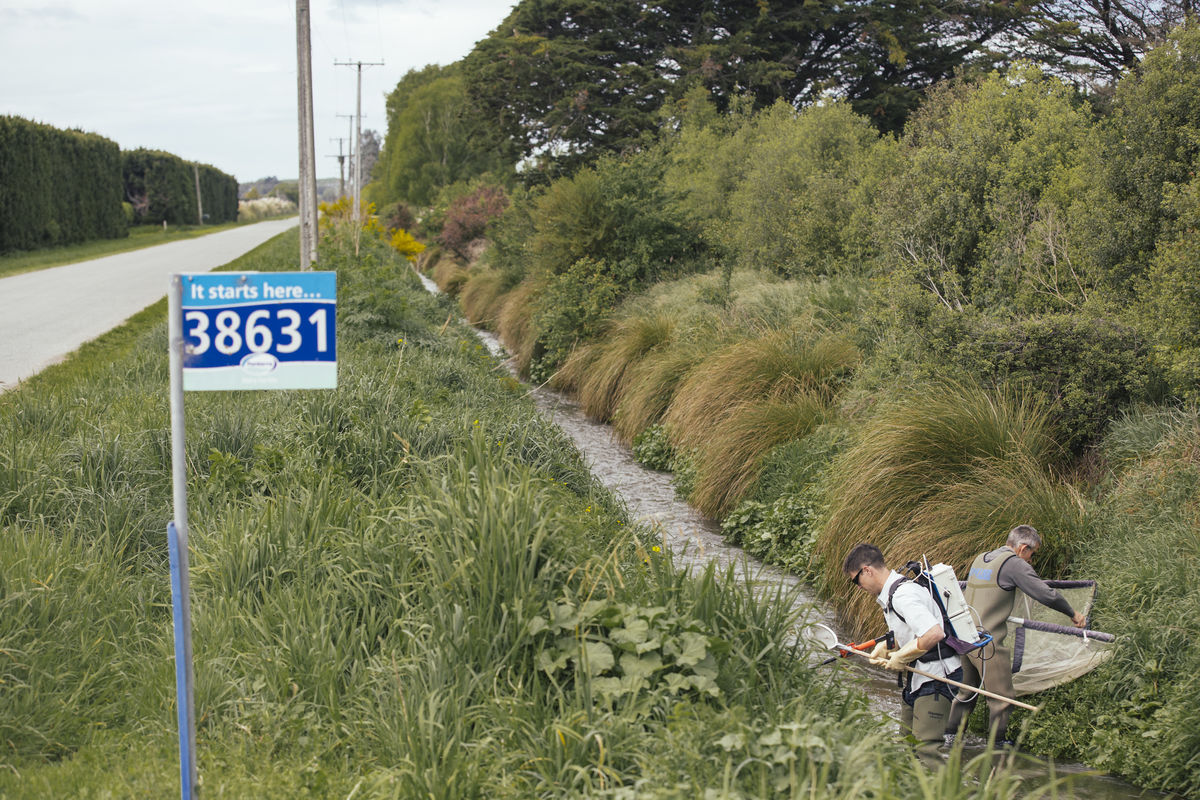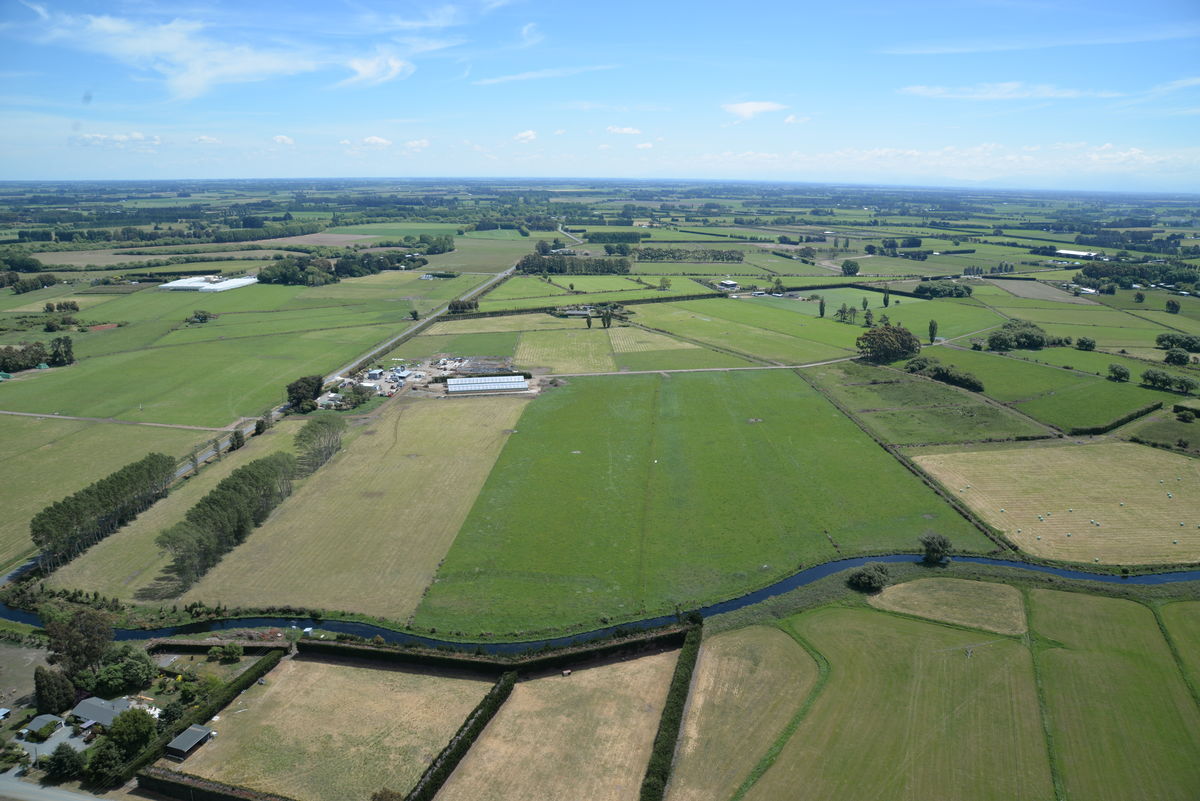
Co-designing solutions for a complex catchment network
The area
The Ararira-LII River catchment is a significant spring-fed tributary of Te Waihora/Lake Ellesmere, New Zealand’s fifth largest lake and an important wetland ecosystem in lowland Canterbury. Te Waihora has special significance to Ngāi Tahu as a tribal taonga representing a major mahinga kai and source of mana.
Unique features of this 6,600 hectare catchment include headwater springs, an extensive network of drains/waterways, and two large wetland areas – Tārerekautuku/Yarrs Lagoon and Yarrs Flat. Despite significant modification, the catchment’s network of artificial waterways and remnant wetlands still provide some habitat for native fish, bird and plant species.
Prior to human arrival, much of the land in this area was swamp forest dominated by kahikatea and matai. Numerous waterways, arising as springs, followed irregular meandering courses through the swamp to Te Waihora. To enable European settlement in the mid-1800’s, drains were dug through the wetlands to lower the water level and dry soils enough for farming. Although the swamp forest has long gone, the spring water, now channelled in artificial watercourses, still supports fish and invertebrates and the water quality has a critical bearing on the health of the lake.
The waterways lack shade, allowing aquatic weeds to flourish, choking waterways and trapping sediment. Water weeds and sediment are routinely removed using diggers. The mechanical clearance combined with sediment run-off from eroding banks, and nutrients and contaminants from farms and urban areas, have an adverse effect on freshwater quality. Sections of the waterways not effected by excessive sediment have clean gravel bottoms, providing ideal habitat for native freshwater species such as tuna/eels, inanga/whitebait, koura/freshwater crayfish and some invertebrates.
While the water quality and habitat in the drains is poor, Sarah Yarrow, Living Water National Manager, said they provide some of the only remaining habitat for aquatic invertebrates, plants and fish.
“That’s what motivated Living Water to select the Ararira-LII catchment for its 10-year programme of trialling new tools, methods and approaches to enable farming, freshwater and healthy ecosystems to thrive side-by-side. Living Water’s key focus in the Ararira was transforming the drainage network into a healthy freshwater ecosystem in a productive agricultural landscape. From small scale trials conducted in this catchment, we learnt it’s possible to rehabilitate waterways with gently sloped and planted banks, pools and faster-flowing riffles without reducing the drainage capacity.”
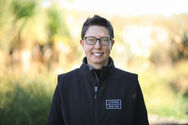
Sarah Yarrow
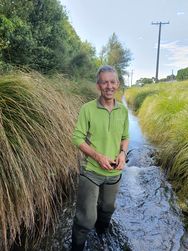
Robin Smith
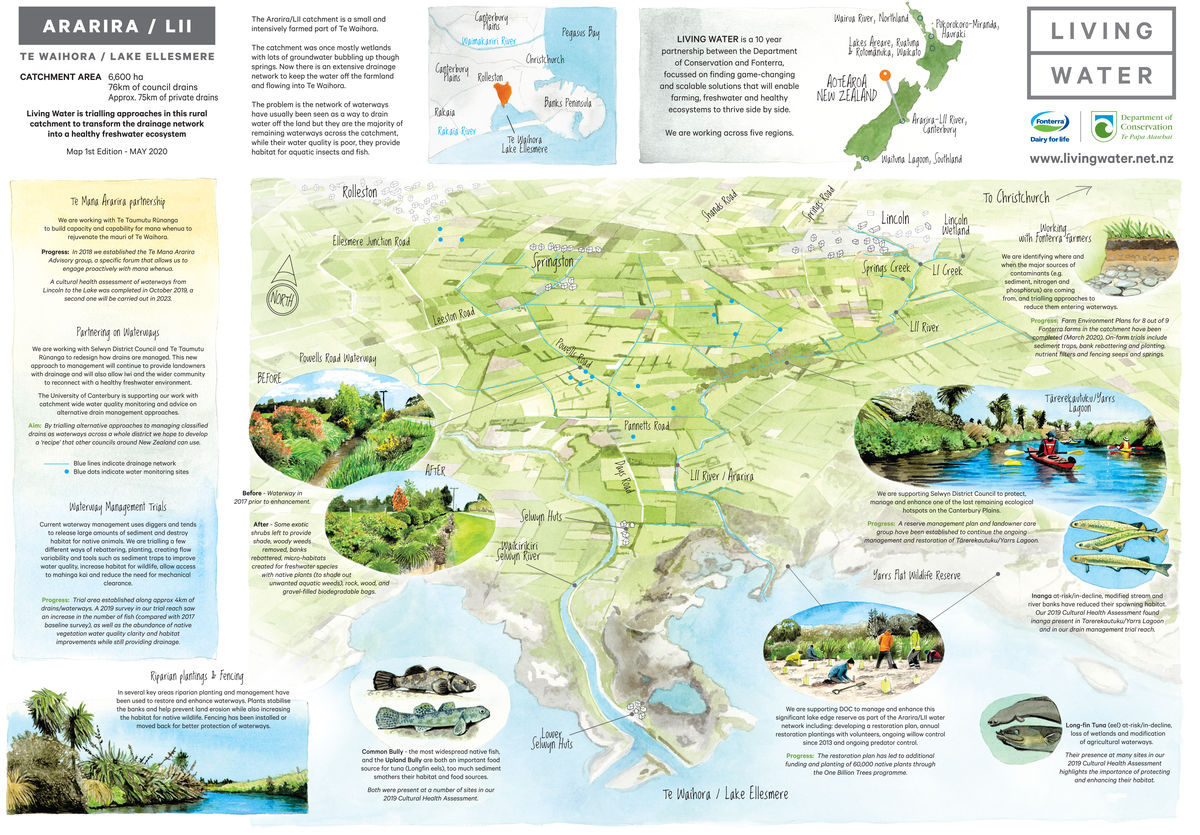
Mending the mauri of Te Waihora/Lake Ellesmere
Living Water, a partnership between the Department of Conservation (DOC) and Fonterra, was a ten-year programme (2013-2023) to find ways to improve freshwater ecosystem health while enabling farming to thrive. Five catchments, all with intensive dairying and challenging freshwater issues, were selected to trial a variety of tools and approaches.
The Ararira-LII catchment was selected because, although highly modified with waterways which are primarily managed for land drainage, it is a significant source of water for Te Waihora and contains remnant habitat for native fish, bird and plant species. Modification of the landscape in the catchment has impacted on cultural identity. That led to the decision to work with Te Taumutu Rūnanga to build capacity and capability for mana whenua to rejuvenate the mauri of Te Waihora.
Te Waihora and its contributing catchments have significance for Ngāi Tahu as a tribal taonga and mahinga kai. Te Taumutu Rūnanga is a key Papatipu Rūnanga with interests in Te Waihora, and in particular, the Ararira catchment. Living Water recognised that working in partnership with mana whenua was critical for freshwater aspirations to be realised.
“Our relationship with Te Taumutu Rūnanga was formalised in 2018 and an advisory group, Te Mana Ararira, established to provide structured engagement between the Rūnanga, Living Water and other groups and agencies who have an interest or are working in the Ararira-LII catchment”, said Yarrow. “Building mutual respect and common understanding included increasing capability and capacity for mana whenua to be involved in freshwater management. Through Te Mana Ararira we worked together to help realise the aspirations of mana whenua for the catchment – to rejuvenate the mauri and life supporting capacity of Te Waihora/ Lake Ellesmere”.
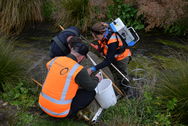
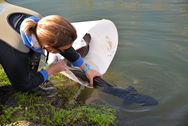
Ararira Cultural Health Assessment
Addressing the sediment, smothering weeds and substandard habitat
Key issues identified in the Ararira-LII were excessive fine sediment and aquatic weeds, that both lead to degraded habitat, poor water quality and a reduction in drainage capacity. These problems drive the annual mechanical clearance of weeds and sediment which, while maintaining drainage, causes habitat damage.
Living Water trialled a variety of tools and approaches to manage waterways to provide effective drainage while minimising or eliminating mechanical clearing. Trial areas were established along approximately 4 kilometres of drains/waterways. Steep banks were re-shaped to reduce erosion, riparian planting was added to provide shade to reduce aquatic weeds and increase habitat, and large stones were added to increase in-stream habitat variability.
“The Powell’s Road waterway enhancement project was a trial to evaluate and demonstrate new ways of sustainably managing a Selwyn District Council (SDC) ‘classified drain’ with the end goal of restoring habitat and water quality for freshwater biodiversity and mahinga kai while maintaining the waterway’s drainage function”, said Yarrow. “As a demonstration site it was highly visible to surrounding landowners and the local community. Springston Primary School became involved in 2018 and their students learned about the waterway’s values and heard about waterway restoration from experts. They researched, designed and implemented a 50-metre section and shared their ideas with others..”
One of Living Water’s partnerships in the Ararira-LII was with the University of Canterbury Waterway Rehabilitation Experiment (UC-CAREX) team. From 2017 UC-CAREX worked with dairy farmers to identify the major sources of contaminants (nitrogen, phosphorus, bacteria and sediment) entering waterways in the catchment and trialling 'edge of field' tools to treat and prevent contaminants from entering waterways. Yarrow said through the UC-CAREX catchment-wide tool-scoping and monitoring work, priority actions were identified and implemented in the right place and monitored. Sediment traps, an in-stream two-stage channel and a wood-chip bioreactor to reduce in-stream nitrate were designed and built and their performance was monitored.
“Baseline monitoring of the catchment started in 2018 and enabled us to assess priority actions”, said Yarrow. “By involving landowners, they learnt what tools are available and how they work. Pleasingly all Fonterra farms in the catchment completed Farm Environment Plans and prioritised actions for reducing nutrient and sediment loads to improve freshwater ecosystems. On-farm trials used by farmers included sediment traps, bank re-battering and planting, nutrient filters and fencing of springs. We know the future of farming will be different and these trials charted a path to a future for freshwater and farming thriving together.”
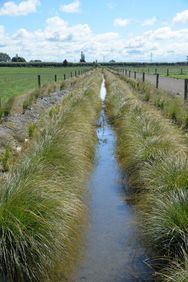
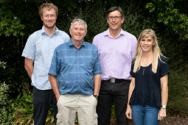
Carex Team
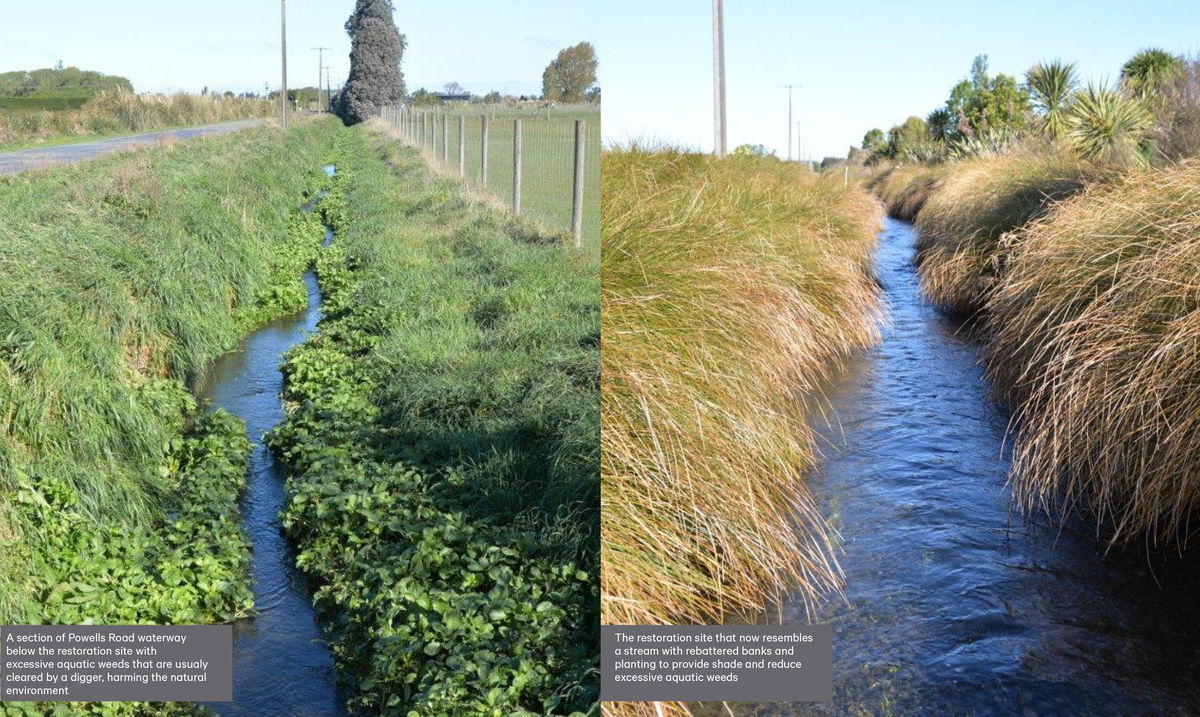
One of the most significant remaining biodiversity hotspots on the Canterbury Plains is Tārerekautuku / Yarrs Lagoon, a 77-hectare reserve in the heart of the Ararira-LII catchment. The lagoon is a wetland remnant and a key biodiversity site. Living Water supported Selwyn District Council (SDC), who own and manage the lagoon, to control willow and other weeds at priority sites, support the development of a management and restoration plan for the Lagoon and the sourcing of funding for wetland rehabilitation.
Little was known or ever recorded about the wetland’s values. In 2016 Living Water, in partnership with Lincoln University, funded an ecological assessment to guide future restoration and conservation of native species.
“The research confirmed the wetland provides habitat for many species of threatened wetland plants as well as tuna/eels, bullies, inanga and introduced brown trout,” said Yarrow.
A Memorandum of Understanding was signed with SDC, and funding provided by Living Water from 2016 to 2018, to co-fund a Biodiversity Coordinator role. SDC confirmed the Biodiversity Coordinator role as a full-time, permanent position from 2018. The Biodiversity Coordinator worked alongside the Living Water Ararira-LII Site Lead to progress waterway restoration initiatives across the catchment. SDC has since established two further full-time Biodiversity Coordinator roles.
“Since we began work with willow control at key sites in the lagoon in 2016 we didn’t look back”, said Yarrow. “Baseline environmental assessment work was completed to support SDC’s development of a Tārerekautuku / Yarrs Lagoon Management Plan. A landowner wetland care group was established to continue the ongoing management and restoration of Tārerekautuku / Yarrs Lagoon with the aim that it becomes a wetland reserve valued by the community”. In 2022 funding of over $800,000 was successfully secured from the Ministry for the Environment Freshwater improvement Fund for restoration work to be taken forward for Tārerekautuku / Yarrs Lagoon over four years, including weed control within the reserve and on adjoining private land, animal pest control using traps and planting in small areas. Bridges have been installed over some of the key drains for easy contractor access, and it’s hoped that in the future a network of walking tracks will be developed to serve the growing recreational needs of residents in nearby Lincoln township.
Living Water supported DOC to manage and enhance Yarrs Flat Wildlife Reserve, a significant lake edge reserve, downstream from Tārerekautuku /Yarrs Lagoon. In 2015 Living Water began a rehabilitation project with support from Te Taumutu Rūnanga. The project provided funding for community led restoration, weed control and improving public access. An ecological assessment of the Reserve identified natural values and provided advice on how to protect and restore them.
A second, more comprehensive ecological restoration plan looked at wider and ongoing ecological management including weed and animal pest control, planting and vegetation management, waterway and riparian management, monitoring and public recreational use and facilities.
Planting at the Reserve began in spring 2015 with a Te Ara Kākāriki led community planting day. Over the following four years Te Ara Kākāriki ran Kids Discovery Plant-out days with Lincoln, Springston and Leeston Primary Schools. With the Ararira River close by and easy access to the wetland and lake, the Reserve has become an outdoor classroom for local schools.
Yarrow said the initial planting of 5000 natives resulted in about one hectare of new lake margin shrubland and forest.
“Living Water provided initial funding for habitat enhancement, and in 2018 funding was secured from the One Billion Trees Programme,” said Yarrow. “Between 2018 and 2021, 41,000 trees were planted across eight hectares of the wetland’. Watch the video here
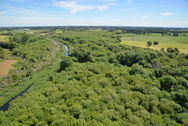
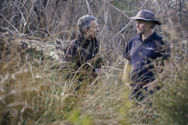
Living Water – Ararira-LII, Canterbury catchment project
Co-designing a new catchment network
Based upon the success of the trials to transform the drains in the catchment, Living Water approached SDC and Te Taumutu Rūnanga with a proposed Memorandum of Understanding (MoU) to work together on re-designing the entire Ararira-LII Drainage District. The goal was to combine small-scale trials with other mitigations, such as strategic land use change, surface water treatment wetlands and large scale sediment traps, to create a plan that supports ecological, cultural and drainage values across the whole catchment.
The MoU was signed in October 2020, and officials from DOC, Fonterra, Taumutu, SDC, Environment Canterbury (Regional Council) and the LII Drainage Committee began work in January 2021 to develop a shared vision for the Ararira-LII catchment and support the development of an integrated catchment management plan. Advice was sought from local stakeholders and consultants were engaged to support the preparation of a plan and implementation guide.
In a gathering by the Liffey Springs on 28 April 2023, the completion of the Catchment Management Plan (CMP) and Implementation Guide (IG) for the Ararira-LII River catchment was celebrated by stakeholders and the community, including Ararira Springs Primary School. Yarrow said the vision for the Ararira CMP was to fundamentally change the management and value placed on waterways by integrating ecological and cultural principles into the design of the drainage network, while acknowledging the importance of land drainage.
‘This catchment redesign entailed a significant shift in mindset and functional design of the drainage systems and their maintenance in order to support ecological and cultural values’, said Yarrow. ‘The project offered a recipe for change and provided guidance in several crucial areas to facilitate a collaborative and comprehensive approach to implementation.’
The CMP outlines how to manage the Ararira-LII Drainage network to enhance biodiversity and cultural outcomes while providing effective drainage. Yarrows said the CMP includes a suite of catchment-scale and 'toolbox' solutions designed to improve the network of ephemeral and perennial waterways in the Ararira-LII catchment.
‘The CMP provided a vision for the desired change, and the accompanying IG offers guidance across a range of key activity areas to support a collective and joined-up approach to implementation and management’, said Yarrow. ‘These areas include developing a shared direction, providing communication and engagement approaches that support collective action and capacity building. Other areas include financial pathways, planning and consenting implications, alternative management or institutional arrangements, monitoring and evaluation, and the potential phasing of these social and technical activities that align with the broader range of catchment values.’
The CMP and IG enables SDC to be "plan ready" to improve the health and mauri of Te Waihora and the Ararira-LII catchment. Yarrow said these plans could be applied to other drainage districts within the Te Waihora catchment and similar lowland regions across New Zealand.
‘We’ve demonstrated the benefits of co-designing a process to change waterway management and the efficiencies of working at a catchment scale’, said Yarrow. ‘We’ve proven that managing for ecological and cultural benefits can co-exist with maintaining drainage.’
In the Ararira-LII catchment this new approach will continue to provide landowners with drainage, enabling productive land use to continue and allow iwi and the wider community to reconnect with a healthy freshwater environment that supports native biodiversity. Yarrow said it’s not a choice of farming or the environment when both can and must co-exist.
“Farming needs uncontaminated freshwater as much as native biodiversity”, said Yarrow. “From what we learnt from the trials in the Ararira-LII, we know that with careful planning and rehabilitation, waterways that support native plants, fish and birds can also effectively provide land drainage. Imagine the difference it will make to the Ararira-LII catchment and waterways across New Zealand as we restore our drains to the life-giving places they once were and can be again.”
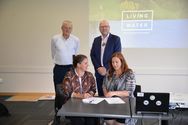
We’re creating partnerships like this because no single organisation or sector has all the skills, knowledge and influence to improve freshwater health and we know it requires more than just on-farm action’, says Yarrow. “By partnering we are making it easier for farmers, iwi and communities to improve freshwater which is a goal we all share
